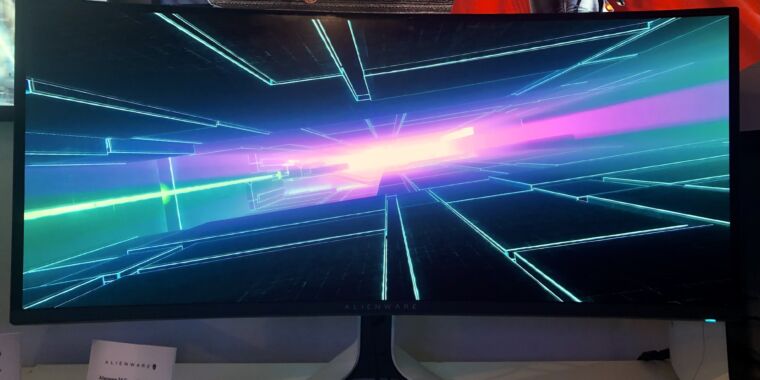Scharon Harding
Burn-in is always possible with OLED displays, but for computer monitors, which tend to display static content (like icons and taskbars), the risk is even more concerning than with other OLED devices, like TVs.
Generally, OLED monitors are way better at fighting burn-in than before, thanks to improved OLED materials, compensation algorithms, brightness efficiencies, manually operable features, and heat management techniques.
At the same time, there’s still much to learn about OLED monitor burn-in. Since OLED monitor selection only started significantly improving over the last couple of years, long-term usage is minimal. Further, new types of OLED monitor technologies, like QD-OLED, are still evolving.
Underscoring this is RTINGS’ ongoing longevity test of TVs and three OLED monitors. Recently, RTINGS detailed findings of an unexpected quirk of OLED monitor burn-in risk that applies to ultrawide designs.

RTINGS included three OLED monitors in its longevity test, which seeks to simulate 10 years of use within two years; however, the monitors have only been tested for six months so far. Two of those monitors, Alienware’s AW3423DWF and Samsung’s Odyssey G8, use 21:9 QD-OLED panels from Samsung Display. RTINGS’ test originally ran a non-stop, 16:9 CNN feed on the displays.
Samsung Display confirmed that running content with black bars on the left and right side of the content results in the monitors’ average picture levels changing; the monitors make the center area brighter than the unused areas.
In a video shared on YouTube on Monday, a RTINGS representative said that the 21:9 monitors showed “heavy differential wear” after 700 hours of playing the 16:9 feed. The left and right sides of the displays, where black bars were during the 16:9 feed, were brighter than the central area of the monitors. To the eyes, the effects weren’t huge but were noticeable if you tried really hard to see it, at which point they became hard not to see, RTINGS’ rep said.
-
RTINGS boosted the shadows on the right image to make the problem more noticeable.
-
Displaying a test slide on Alienware’s OLED monitor makes it easier to see how the sides are brighter than the middle.
Higher brightness can lead to quicker degradation of the OLED layer. If RTINGS didn’t change its testing so that the CNN feed ran full-screen, “it’s very likely” that the ultrawide monitors would’ve seen “damage” that’s “irreversible and noticeable,” RTINGS’ spokesperson said. (RTINGS said it addressed the monitors’ uniformity problems by running long compensation cycles.)
RTINGS reported that when playing the CNN feed in the 16:9 format on its ultrawide OLEDs, the CNN logo hit 161.9 nits. compared to 141.9 nits when stretched to 21:9. A square near the upper-left corner of the CNN feed was 190.7 nits in 16:9 and 175.6 nits in 21:9.
RTINGS’ test puts displays through extreme scenarios that the vast majority of users would never put their devices through. But watching 16:9 content on a 21:9 monitor is not an unreasonable application. And the idea that watching CNN long-term in 16:9 on a 21:9 ultrawide monitor could impact a monitor’s risk of burn-in is something that could easily be overlooked. Even RTINGS, a respected reviews website, didn’t realize doing its testing in 16:9 would affect its ultrawide monitors’ brightness levels until Samsung reached out to it.
The longevity test is ongoing, but at the six-month mark, which represents 3,600 hours and simulates 2.5 years of use, the three tested OLED monitors (the third being LG’s 27GR95QE-B) are showing minimal OLED degradation and “expected” aging, RTINGS said.
More to learn
Burn-in risk reduction and growing selection have made OLED monitors a more viable option than ever, but RTINGS’ testing illustrates how much more there is to learn about various types of long-term OLED monitor use and how the longevity of these devices can improve.
Even OLED monitors that have already been released can see their capabilities change in a way that could impact burn-in risk. For example, the Odyssey G8 monitor got a firmware update in August that removed the ability to use the Peak Brightness setting in SDR mode. While this is just one specific mode that, again, some users might not use, it’s worth noting how this could change the amount of wear an OLED monitor could see. RTINGS’ review said after the firmware update, the monitor’s max luminance “when displaying a bright highlight in an SDR scene” went from 331 nits to 230 nits.
Samsung hasn’t confirmed why it made this change (we reached out for comment), but such changes highlight how OLED monitor burn-in risk can change from use to use and from update to update, and across different products.
Again, there are many techniques and features for alleviating burn-in threats. But for those concerned about monitor longevity and sustainability, there’s a lot to learn and, certainly, room for OLED monitors to improve. In addition to improvements the displays can make around other issues—like price and text clarity—more insight into how these displays handle OLED degradation is welcome.
For more on RTINGS’ longevity test, check out its website, as well as the 10-month update video below:
10-month update about permanent burn-in on OLEDs and QD-OLED monitors.
Denial of responsibility! My Droll is an automatic aggregator of Global media. In each content, the hyperlink to the primary source is specified. All trademarks belong to their rightful owners, and all materials to their authors. For any complaint, please reach us at – [email protected]. We will take necessary action within 24 hours.


